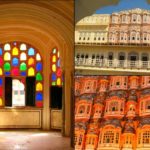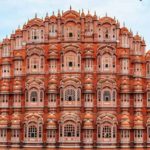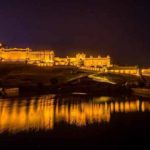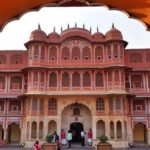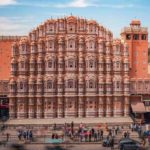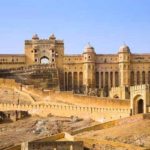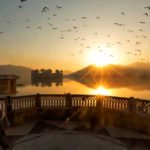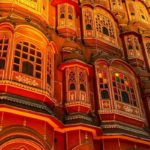Hawa Mahal Jaipur
The renowned ‘Palace Of The Winds’, or Hawa Mahal, is one of the prominent tourist attractions in Jaipur city. Located in the heart of Jaipur, this beautiful palace was constructed in 1799 by Maharaja Sawai Pratap Singh who belonged to Kachhwaha Rajput dynasty. it was essentially a high screen wall built so the women of the royal household could observe street festivals while unseen from the outside. Hawa Mahal is famous for its windows or ‘Jharokhas‘ which enable free circulation of air within the structure.

There is a small museum located in the premises of Hawa Mahal that houses ancient artifacts related to the Rajput lifestyle. It is located right in the center of the city and can be easily reached from anywhere in Jaipur.
City Palace, Jaipur
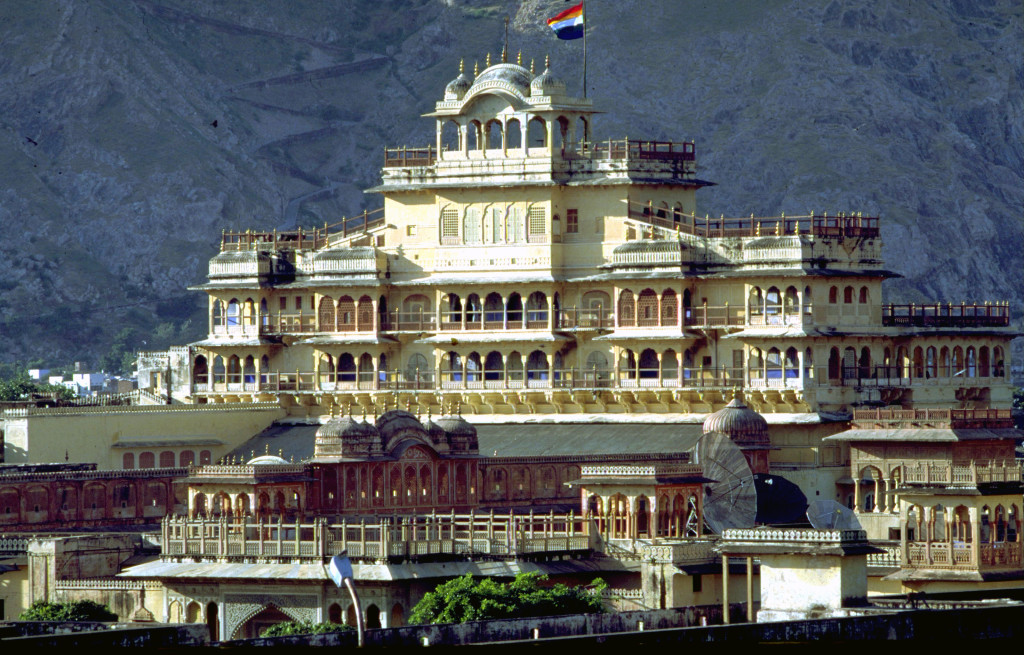
Located in the heart of the Pink City Jaipur. The City Palace Complex includes the Mubarak Mahal (the palace of reception) and the Maharani’s Palace (the palace of the queen). Mubarak Mahal now houses the Maharaja Sawai Man Singh II Museum and displays a vast and unique collection of royal costumes, delicate Pashmina (Kashmiri) shawls, Benaras silk saris, and other dresses with Sanganeri prints and folk embroidery. The clothes of Maharaja Sawai Madho Singh I are also on display. The Maharani’s Palace, surprisingly, has an interesting display of very well-preserved Rajput weaponry, some dating back to the 15th century. Other than the arms, the palace is adorned with beautiful paintings on the ceiling that are well-maintained.
Amer Fort
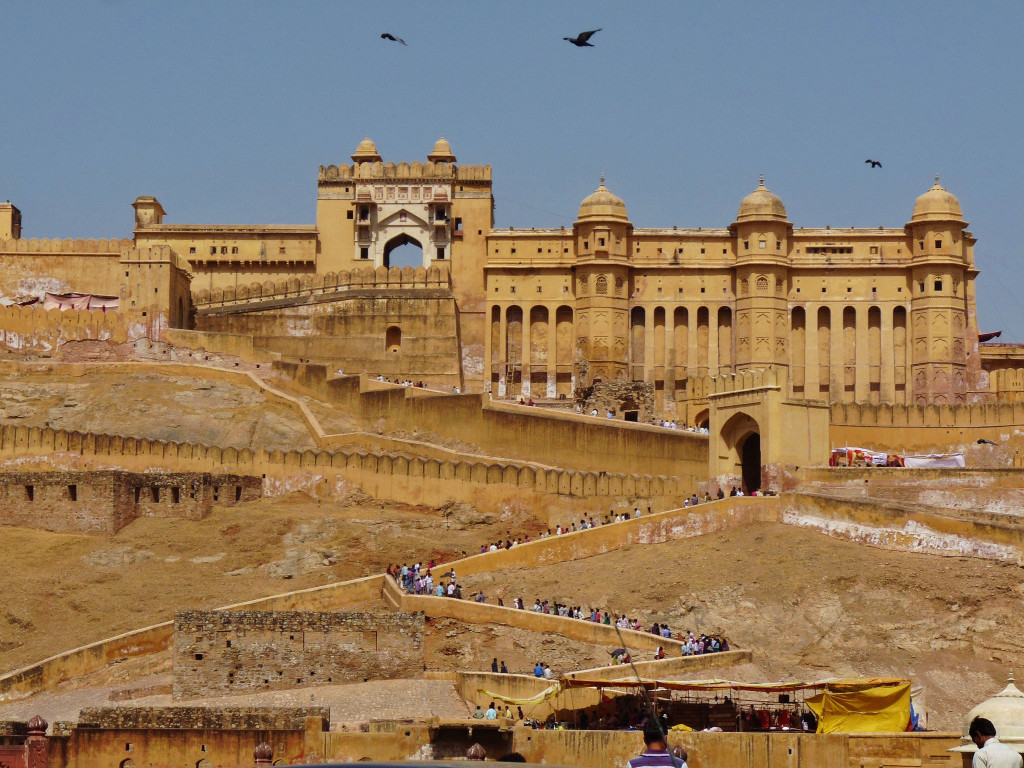
Amber (pronounced Amer) is at a distance of about 11 kilometres from Jaipur.
The palace, located in craggy hills, is a beautiful melange of Hindu and Mughal styles. Raja Man Singh I began construction in 1592 and the palace, which was built as a strong, safe haven against attacking enemies, was completed by Mirja Raja Jai Singh. Amber Fort is known for its artistic style, blending Rajput elements. With its large ramparts, series of gates and cobbled paths, the fort overlooks the Maota Lake, at its forefront. Major attractions of Amer are : Diwan-e-Aam, Diwan-e-Khaas, Ganesh Pol, Jaleb Chowk, Singh Pol, Jai Mandir, Yash Mandir, Sukh Mandir, Sheesh Mahal (Hall of Mirrors), Suhag Mandir, Shila Devi Temple, Bhool Bhulaiya, and Zanana Dyodhi .
Jantar Mantar Jaipur
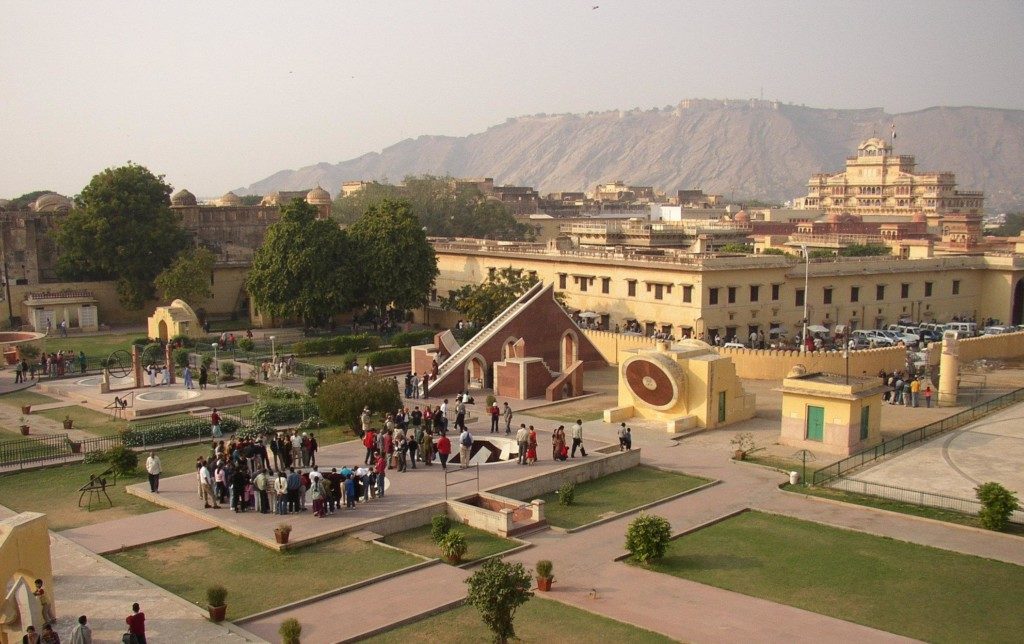
The Jantar Mantar in Jaipur is considered to be the largest of the five astronomical observatories built by Maharaja Sawai Jai Singh II, the founder of Jaipur. The Universe and the Cosmos have always been of interest to man, and it was this interest that compelled the Maharaja to build an astronomical observatory. The term ‘Jantar Mantar’ is derived from the Sanskrit terms ‘Yantra’ and ‘Mantra’ meaning ‘instruments’ and ‘formula’ respectively. The term ‘Yantra’ was replaced with ‘Jantar’ which means ‘magical’. The Jantar Mantar houses various architectural and astrological instruments that have caught the interests of astronomers, historians and architects around the world.
Nahargarh Fort
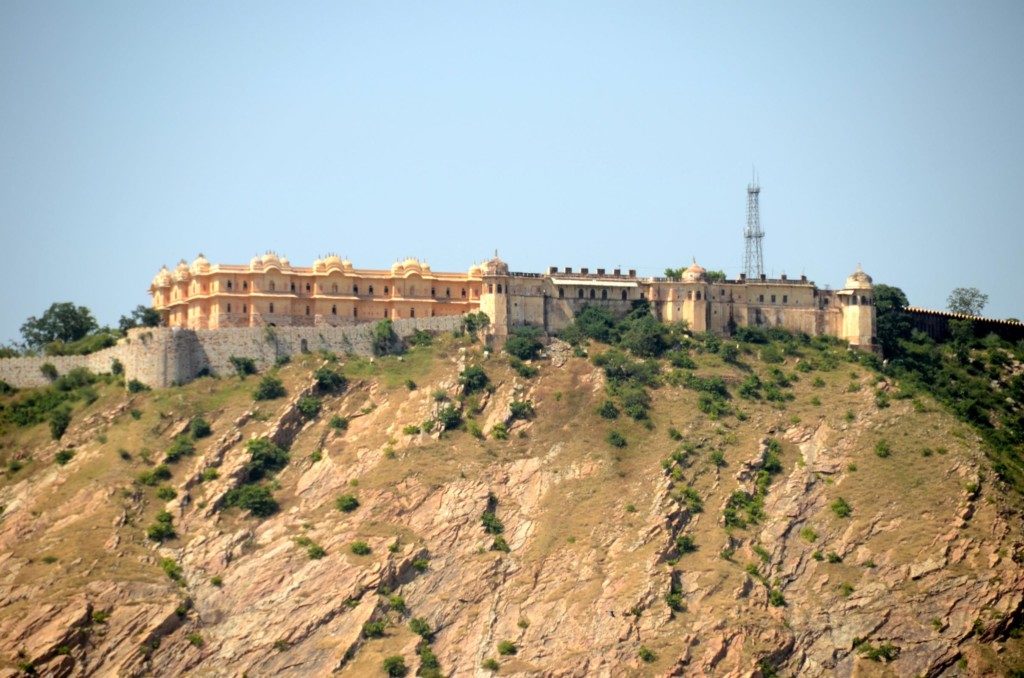
Nahargarh Fort was built in 1734 by Maharaja Sawai Jai Singh II, founder of Jaipur . The northern frontier of Jaipur is fortified by Nahargarh Fort. Situated on a rough crest of the Aravalli range, the fort, which literally means ‘abode of the tigers’. Nahargarh Fort is connected to the Jaigarh Fort through its fortifications. It is believed that the construction of this fort was obstructed by the spirit of a Rathore prince, Nahar Singh Bhomia. However, the spirit was pacified when a temple dedicated to him was built inside the fort. This is a two-storey building which has suites for the king and his twelve queens. It is divided into nine similar apartments and each of these apartments has a lobby, bedrooms, toilets, kitchen and store. Other structures inside the palace include Diwan-I-Aam, an open air enclosure where the king met the common men and listened to their problems and complaints.
Jal Mahal Palace
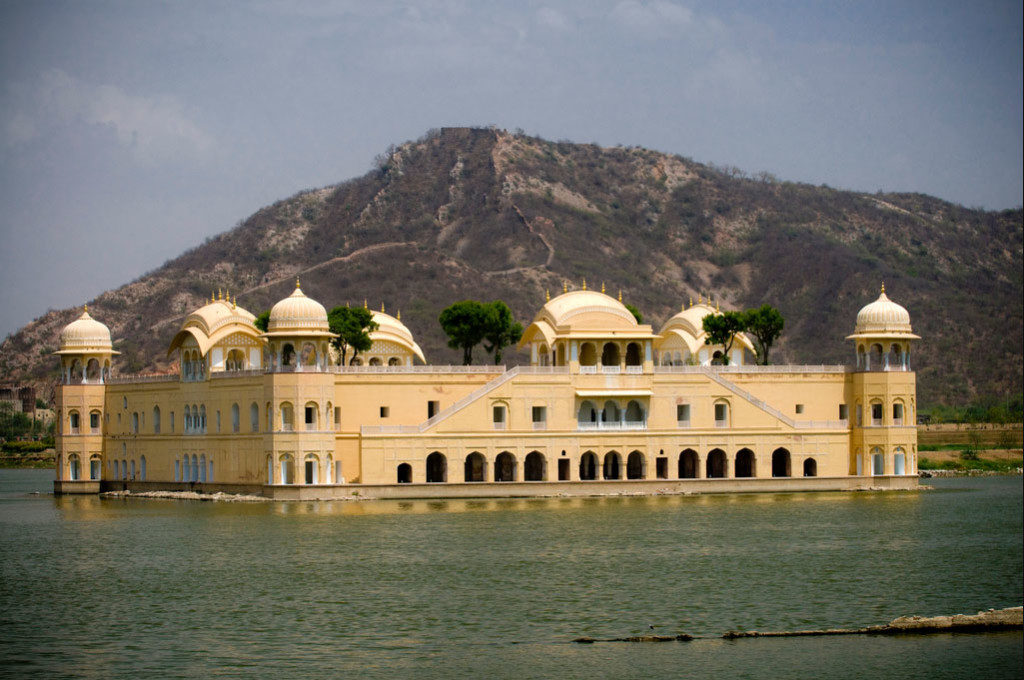
Jal Mahal which literally means the “Water Palace” is a palace located in the middle of the Man Sagar Lake in Jaipur city. The palace and the lake around it were modernized and enlarged in the 18th century by Maharaja Jai Singh II of Amber. Jal Mahal, that means water palace in English, is a beautiful place that is located in the center of the lake Man Sagar, in Jaipur. the lake used to be a bird watcher’s paradise in the past and was a favorite ground for the Rajput kings of Jaipur for royal duck shooting parties during picnics. The lake was home to more than 150 species of local and migratory birds that included Large Flamingo, Great Crested Grebe, Pintail, Pochards, Kestrel, Coot, Redshank, Marsh Sandpiper, Ruff, Herring Gull, Red-breasted Flycatcher, Grey Wagtail, but their numbers declined with the worsening of the lake
Jaigarh Fort
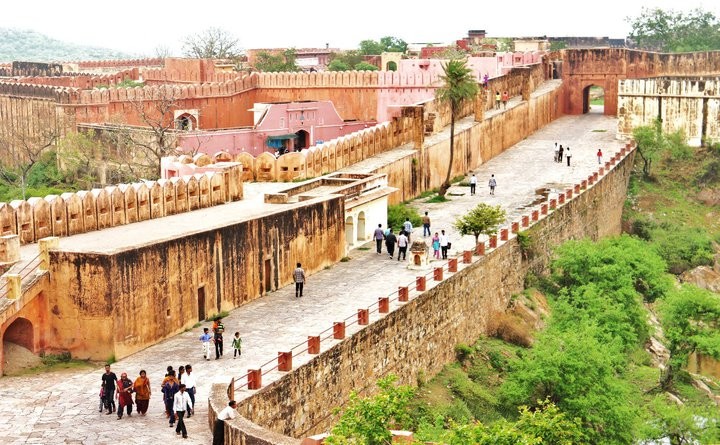
The Jaigarh Fort is a majestic stronghold built by Sawan Jai Singh II. Jaigarh Fort is situated on the promontory called the Cheel ka Teela of the Aravalli range. The Jaigarh Fort was built to secure Jaipur City and the Amer fort from warlords and rivals The fort houses the world’s greatest cannon on wheels known as the ‘Jaivana Cannon’ and a huge palace complex. This includes the Laxmi Vilas, Lalit Mandir, Aram Mandir and the Vilas Mandir. The fort has a well-tended garden which can be viewed by tourists even today along with an armory and a museum. The Jaigarh fort was never conquered in battle, and was also the strongest of the three forts in Jaipur. During the Mughal dynasty, the fort bore witness to an ambush by Aurangzeb who defeated and killed his own brother who was the overseer of the cannon outpost in the fort. Apart from that, the fort never witnessed any major resistance, and only test-fired the world’s largest cannon, once!
Albert hall Museum
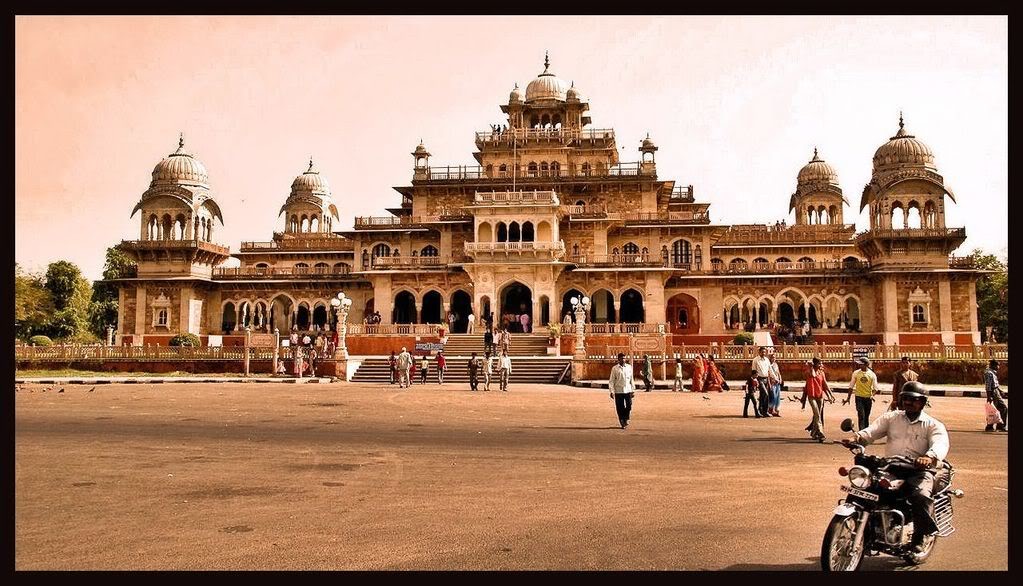
The building gets its name from The Victoria and Albert Museum in London, the inspiration for its design. The Albert Hall was completed in 1887 by the architect Samuel Swinton Jacob,Director of Jaipur PWD. its Indo-Saracenic architecture and stone ornamentation, became a source of reference for varied classical Indian styles of design from Mughal to Rajput. Even the corridors were decorated with murals in a variety of styles including the Ramayan, reproducing paintings from illustrations in the Persian Razmnama prepared for Emperor Akbar. European, Egyptian, Chinese, Greek and Babylonian civilizations were portrayed in the other murals to enable the people of the region to compare and contrast them with their own and develop their knowledge of history and art.
The museum displays a wide range of metal objects, wood crafts, carpets, stone and metal sculptures, arms and weapons, natural stones and ivory goods. It also houses a large collection of miniatures from Bundi, Kota, Kishangarh, Udaipur and Jaipur schools of art.
Birla Temple
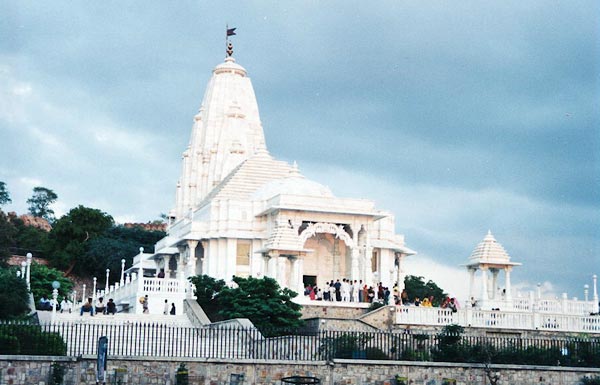
The Birla Temple, originally known as Lakshmi Narayan Temple, and is situated below the Moti Dungri Fort in Jaipur. Dedicated to Lord Vishnu and Goddess Lakshmi, this temple is a proud architectural landmark of Jaipur. Built in pure white marble, the Birla Temple is unlike the traditional ancient Hindu temples, and is built with a modern approach. Inside this magnificent shrine, beautifully sculpted idols of Lord Vishnu and Goddess Lakshmi, as well as other Hindu Gods and Goddesses, can be seen. the Birla temple was built on the land given to the Birla family by the Maharaja, for just a token sum of one rupee. One of India’s most famous business families, B.M Birla Foundation, built this temple in the year 1988. Apart from the religious idols, pictures and figures of several religious saints, philosophers and historical achievers, like Socrates, Buddha, Zarathustra and Confucius, are also included in the temple. A work of art, this temple truly represents architectural beauty, in a modern form.
Galtaji Monkey Temple
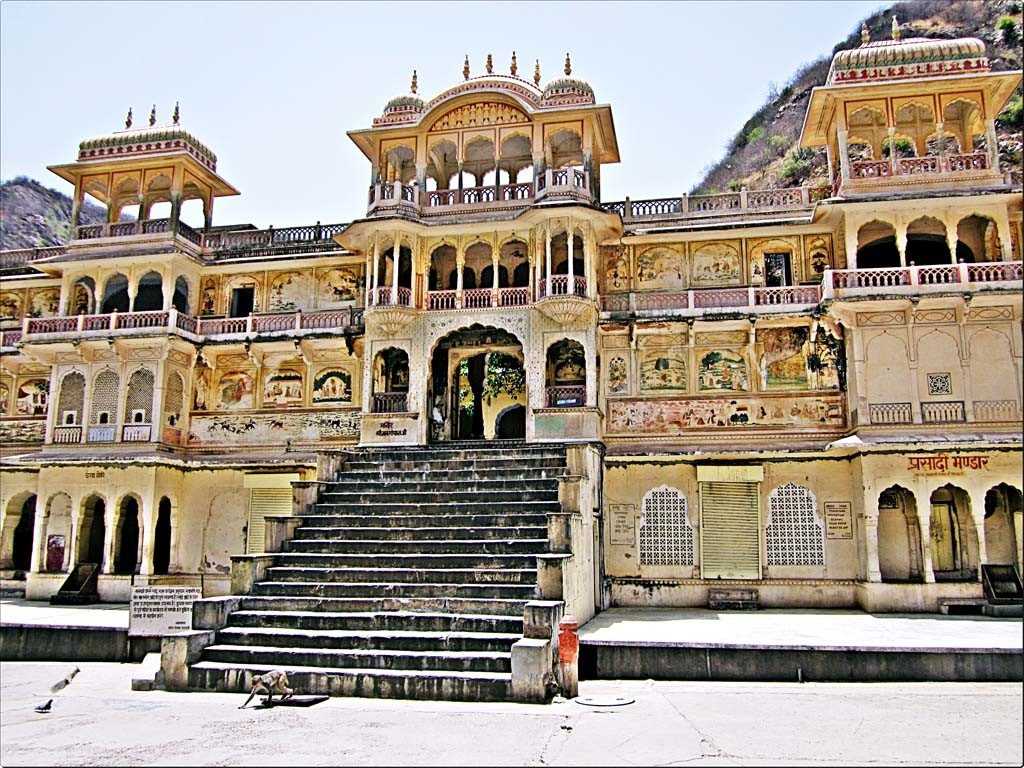
The Galtaji Temple is located in the Aravalli hills and is bounded by dense trees and bushes. This impressive building is ornamented by painted walls, adorned by rounded roofs and pillars. Apart from the kunds, there are temples of Lord Ram, Lord Krishna and Lord Hanuman situated within the temple complex. Diwan Rao Kriparam, an attendant to Sawai Jai Singh II, in the 18th Century, built the Galtaji Temple.
The temple complex encompasses natural fresh water springs and 7 holy ‘kunds’ or water tanks. Among these kunds, the ‘Galta Kund’, is the holiest one and is believed to never get dry. A spring of pure water flows from the ‘Gaumukh’, a rock shaped like a cow’s head, into the tanks. This temple is famous for the many tribes of monkeys that dwell in this area.

